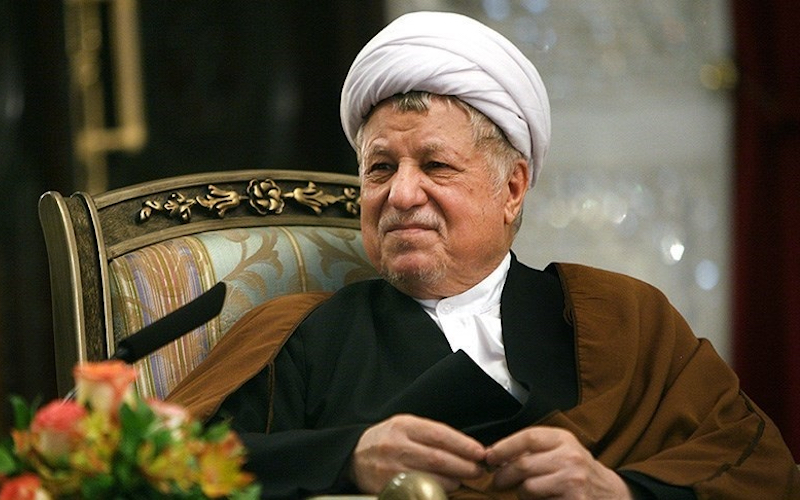
Rafsanjani’s Legacy: The Father of Neoliberalism in Iran
Ali Akbar Hashemi Rafsanjani was one of the most influential founders of the Islamic Republic of Iran. He was a follower of Ayatollah Khomeini, and was always considered as the second most important politician in Iran. One can compare him with Deng Xiaoping, the former leader of People’s Republic of China. They both were key characters in the ideological revolution that took place in their countries, had important roles in the decision-making process, and also had critical roles during the Cultural Revolutions.
However, their most important shared feature was their interest in economic liberalism. They believed that making peace with the world and introducing their countries to the globalization process would result in development and help solve problems. They did not believe in Western democracy but wanted a kind of elitism and aristocracy. In an interview, Xiaoping responded to the criticism implying that economic reforms contribute to political demands: “when you open a window to refresh the room air, one or two flies might enter as well!” Both remained faithful to their own country’s political system.
The only difference between them was that Xiaoping was twenty years younger than Mao, the leader of the Chinese Revolution, and Rafsanjani was several years older than Iran’s current Supreme Leader, Ayatollah Khamenei. Xiaoping lived to achieve his goals but Rafsanjani died before he was able to.
Iran’s urban middle class has been upset in recent days by Rafsanjani’s death but his critics believe that political repression and oppression was maximized during his presidency, and Iranian’s vote for Mohammad Khatami, the reformist president, reflected the desire to end the repression that prevailed during Rafsanjani’s presidency. Rafsanjani was generally a conservative politician who changed his political stance after the 2009 election and introduced himself as a reformist.
Apart from the fears of the urban middle class and bureaucrats regarding Iran’s fate following Rafsanjani’s death and their concerns about the rise of hard-liners in the near future, an important point about Hashemi Rafsanjani was that the economic adjustment program and pursuit of neoliberal development plans during his presidency had a significant effect on Iran’s economy, politics, and society.
Rafsanjani and his fellows, namely the reformists and President Rouhani, admired the Chinese model which focused on economic growth and viewed economic development as the pre-requisite to political development. On the contrary, the hard-liners criticize the Chinese model as they believe that China has sacrificed its communist ideology for economic profit. Furthermore, unlike Rafsanjani, they worried that Iran might be socially and culturally affected by Western values through economic transactions with the West.
Rafsanjani’s economic policies regarding supporting privatization and the free market economy had great consequences. His economic policies during his presidency intensified class differences. His technocrat managers were not concerned about increased class differences and didn’t take any measures to help the poor. The gap that formed between different classes during Rafsanjani’s presidency was the result of implementing World Bank and International Monetary Fund policies. These institutions granted loans to Iran and determined how they could be used in return. This economic policy resulted in 50% inflation.
At the end of Iran-Iraq war, Rafsanjani took charge of an economy whose production was reduced to one third of pre-war levels. Along with increased oil revenues and receiving foreign loans, he implemented the open door policy. Implementing this program increased importation from 16.5 billion dollars in 1990 to more than 30 billion dollars in 1992, and the inflation rate jumped as a result of increased liquidity. The average oil price increased by 20.27 dollars/barrel during 1990-91, but was reduced to 14.7 dollars in 1993. Thus the economic reforms started by Rafsanjani soon ended. Implementing these policies substantially increased the government’s foreign debt and resulted in a 49.5% inflation rate in Iran in 1996. During this time, the free dollar rate increased by 4.6, rising from 96 Tomans to 444 Tomans. Such a rapid increase was unprecedented in the history of the Islamic Republic of Iran up to that time.
Programs such as privatization, establishing financial and credit institutions in the framework of the First Development Plan (1990-1994) and reopening the stock market were some of the policies during Rafsanjani’s presidency. The government’s critical economic situation lead to its inability to repay the loans. So, he limited imports thus backing off from his plans. His efforts for liberation of the economic and exchange system failed, which resulted in 50% inflation rate and unprecedented foreign debt for Iran.
These policies also triggered some riots in Islam-Shahr, Mashhad, and other cities during his presidency. The reason behind the riots was the decision of Mashhad authorities regarding resolving the problem of marginalization and illegal construction in that city. But the government officials destroyed the building without providing the basic amenities for the comfort of the marginalized people. Therefore, the angry slum dwellers attacked government buildings and set fire to them while protesting in the streets, However, the government suppressed the protests by mobilizing the military and security organizations, executing several people, and arresting thousands of the protesters accusing them of being “thugs” or “rioters.”
Despite these policies, some years later, Ahmadinejad introduced himself as the representative of the poor, workers, marginalized people and the villagers in his campaign slogans, and won the election by creating a bipolar atmosphere against Rafsanjani, who was closer to the rich. However, despite his slogans about social justice, Ahmadinejad implemented the most neoliberal policy, i.e., removing the subsidies, and quickly released the price of fuel carriers.
The activists of the private sector, namely those active in the field of oil, gas, and energy, bankers and bureaucrats were among Rafsanjani’s inner circle of followers, whose rivals were the Iranian Revolutionary Guard. However, it was actually Hashemi Rafsanjani himself who introduced and empowered the economy to the Iranian Revolutionary Guard during his presidency.
At the end of Iran-Iraq war, Rafsanjani allowed the Iranian Revolutionary Guard to enter the economy in an attempt to end Iran’s isolation and find a low-cost reconstruction platform. Besides road construction and civil areas, this body gradually entered the area of banking and industry, and became a rival of the private sector.
Hashemi Rafsanjani was the founder of a neoliberal economic policy which harmed workers and the poor; a policy that has been followed more or less by the subsequent governments of Iran.
